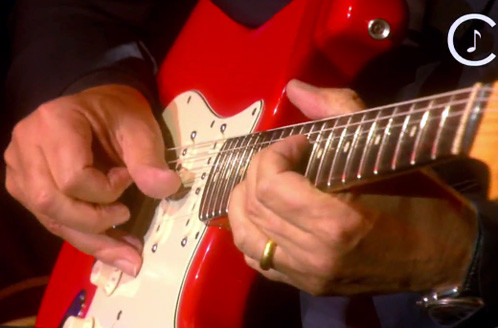For guitarists, there’s a unique thrill in exploring the rich tones of blues guitar, and that experience deepens when you transition to playing fingerstyle. Ditching the guitar pick and relying solely on your Guitar Fingers opens up a new world of expression and nuance on the electric guitar. Think of iconic players like Mark Knopfler, a true master and arguably the most celebrated “fingerstyle” electric guitarist of our time. He proves the power and versatility that guitar fingers can bring to your playing.
 Mark Knopfler playing fingerstyle guitar with his fingers
Mark Knopfler playing fingerstyle guitar with his fingers
Knopfler’s signature “pinching” technique showcases the dynamic control you can achieve with your guitar fingers. He expertly manipulates the strings, primarily using a pinch or “claw” motion between his thumb and index finger. Sometimes, drawing inspiration from legends like Wes Montgomery, he even opts to pluck all the strings exclusively with his thumb, demonstrating the breadth of sounds possible when you use your guitar fingers.
While Knopfler’s style is distinctive, traditional fingerstyle offers another approach. This method typically involves using the thumb for the lower-pitched wound strings (bass strings) and assigning the index, middle, and ring fingers to the higher-pitched treble strings. The pinky finger can either rest lightly on the pickguard for stability or float freely, a point of preference among traditionalists, though many electric fingerstyle players find anchoring the pinky helpful.
To truly understand the nuances, seeing is believing. Mark Knopfler himself has shared insights into his specialized guitar fingers technique in various interviews and demonstrations.
YouTube is also a treasure trove for learning. Guitarists like Andy from Pro Guitar Shop offer fantastic demonstrations of how to harness your guitar fingers on electric guitar, revealing unique approaches and sounds.
And let’s not forget the incredible Sean Costello, a true master of soulful fingerstyle playing, whose legacy continues to inspire. His performances are a testament to the expressive capabilities unlocked when you dedicate yourself to playing with your guitar fingers.
Recently, I decided to set aside my trusty Dunlop Ultex pick, at least for now, and fully commit to playing all my guitars using only my guitar fingers. This transition from the attack of a pick to the softer touch of fingertips has been a journey. It requires patience, methodical practice, and a willingness to explore. However, in this process, I’m discovering a completely new “voice” within my guitar fingers, a voice I never knew existed.
Two primary challenges have emerged as I delve deeper into playing with my guitar fingers. The first is achieving consistent sound. My index finger seems to naturally pluck the G string with confidence and evenness, but my ring finger can be unpredictable. Sometimes the notes are too soft, other times too loud. The goal is to train my thumb and all three fingers to apply a similar attack, creating a balanced and consistent tone. This requires dedicated practice to build the necessary muscle memory in my right hand, specifically for my guitar fingers.
The second hurdle is strumming – creating the full, resonant sound of multiple strings ringing together without a pick. I’m committed to using only the fleshy pads of my guitar fingers, avoiding the use of nails, as the nail sound, to my ear, too closely mimics the bright attack of a guitar pick. I’m seeking a fundamentally different tone, rooted in the warmth of skin against string.
Mark Knopfler often uses his thumb for strumming, and occasionally, he’ll flick his three guitar fingers across the strings, allowing his nails to briefly act as a pick substitute.
Andy from Pro Guitar Shop uses a pinching motion between his thumb and index finger to simulate a pick. On the downstroke, his index fingernail brushes the strings, and on the upstroke, his thumbnail follows. This creates an interesting percussive effect, but I’m hesitant to rely on fingernails, wanting to avoid potential damage and pursue a purely fingertip-based tone.
To my ear, traditional strumming can sometimes sound muddy, a wash of indistinct notes. Instead, I’m experimenting with a “strumming” technique that involves simultaneously plucking four strings. These unison plucks produce a sound reminiscent of a piano, but with the distinctive woody character of a guitar, and the harmonics resonate with a unique richness.
The puzzle I’m currently working to solve is choosing which four strings to pluck when a chord ideally involves six. Do I select four notes from the full six-string chord? Or is there a way to mentally transcribe and adapt chords on the fly, finding voicings that capture the essence of the chord within a four-string framework? These are the questions driving my exploration as I continue to refine my guitar fingers technique and unlock new sonic possibilities.
